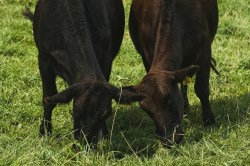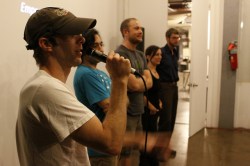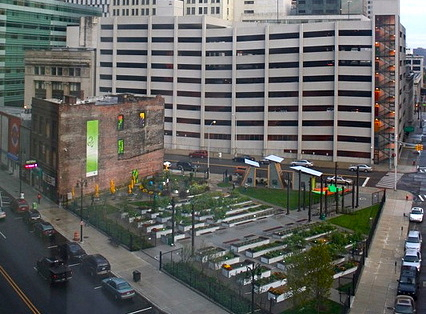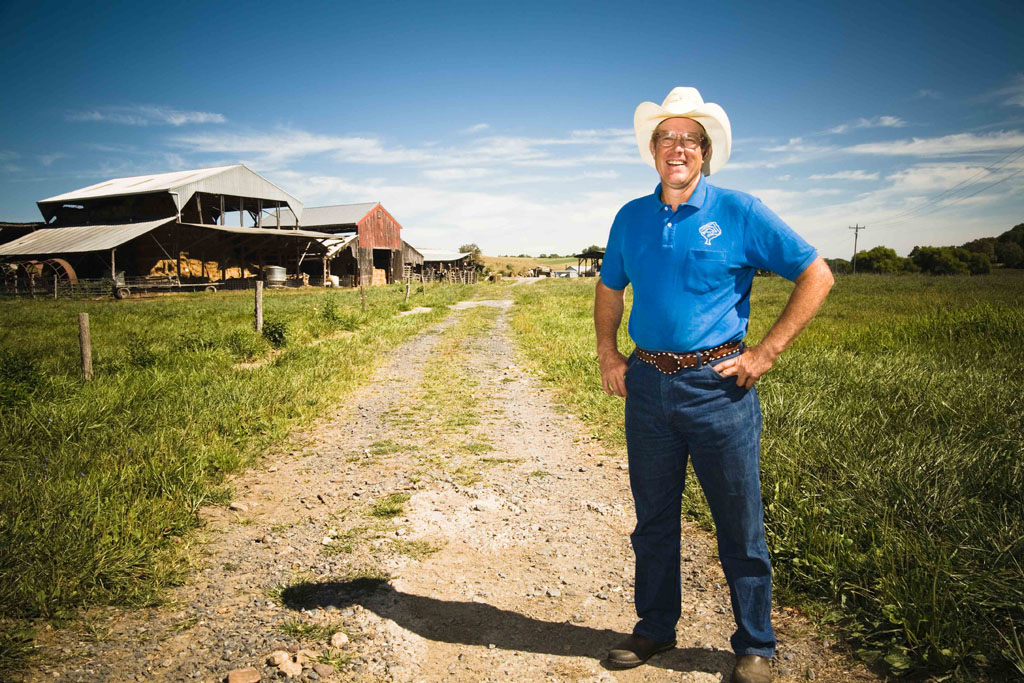
Since I last spoke to director Graham Meriwether about his documentary American Meat, we’ve experienced the Occupy movement, a long, grinding national campaign season, and another brutally hot summer of record-shattering drought, wildfire, and storms. Throughout that time, Meriwether and crew have been traveling the country showing American Meat at Future Farmers of America chapters, high schools, and universities, having conversations with folks invested in every corner of the food system, from sustainable to conventional, small-scale to large. The film explores ways to make America’s meat healthier for producers, eaters, and the environment, shedding light on the struggles and successes of several types of farmer.
Meriwether says the documentary’s first goal is to thank America’s farmers — particularly the younger ones. As they’ve been on the road, Meriwether and his team have been producing short video portraits of young farmers around the country, which they plan to eventually use for their next film.
Meriwether just kicked off a 100-screening tour (10 screenings each in 10 mainly farm states). American Meat didn’t premiere in New York City, and Meriwether didn’t submit it to any film festivals; he wanted to bring it to the kinds of places where he feels the film can have the most impact. We caught up with him between shows in Missouri to hear the latest.

MoviehouseBKGraham Meriweather, at center, on a panel as part of the American Meat screening tour.
Q. How has the agricultural landscape evolved over the last year?
A. The biggest thing that happened this summer was obviously the drought. That made things difficult for every kind of farmer, from grass-based to conventional. Droughts come and go, and this is a really bad one; hopefully it’s not a sign of things to come. But a lot of the issues that we raise in the film are valid regardless of what the weather is.
Q. How has the political climate influenced viewers’ attitudes toward the film?
A. We’ve been having really strong turnouts. We had our kickoff screening at the University of Missouri, and we had 725 people come out, which was way more than we anticipated; it’s also way more than we’ve ever had at another screening. Last night, we were at Truman State University, and we had close to 200 people, and that’s in a community of 17,000. We had 100 people turn out in Cole Camp, Mo., which is a town of 1,000 people. My guess is it probably has something to do with the election; people are more engaged in some of these issues.
I think part of the reason is that we’ve been able to have representatives from every different type of agriculture on our panel discussions. At the University of Missouri we had Don Nikodim, who’s the executive director of the Missouri Pork Producers Association, which is largely supporting conventional hog farmers. And we had an economist supporting conventional concepts. But we also had Paul Willis, the founder of Niman Ranch Pork Company and we had Mary Hendrickson, who teaches sustainable ag. The audience is not just people with the same viewpoint. We often have a constructive conversation about the future of agriculture and the challenges we face.
Q. What’s it like having so many different viewpoints in the same room? How heated do the discussions get?

A young audience at an American Meat screening.
A. Don Nikodim is critical in a respectful way. He doesn’t believe that grass-based systems are going to ever replace conventional systems. [People like Nikodim] have spent a lot of time and money and passion to build a certain system of agriculture, and if you have dedicated your life to that, then of course you’re gonna stand up for what you believe in.
At the University of Missouri screening, it was funny, because after every time Don Nikodim said something, all of the conventional ag students would erupt into applause. And every time Paul Willis or Mary Hendrickson would say something, everyone [else] would erupt into applause. There wasn’t any negative energy; there hasn’t been a single personal attack or anything.
We didn’t premiere the film in New York City, and we didn’t apply to any film festivals — we’re bringing the film to the agricultural regions where it’s really vital. I think that’s why we’ve had these types of discussions. And often we find that we’re agreeing on a lot of things.
Q. What are some of the things people agree on?
A. One story I often tell — and I haven’t seen anyone [from the conventional side] disagree — would be that [of] Chuck Wirtz, a conventional hog farmer in our film. He told me that when he started farming they had a two-row cultivator. Five years ago they had a 24-row cultivator, and now they don’t even have a cultivator because they just spray pesticides to get rid of the weeds. The point is that conventional agriculture is incredibly efficient, and it’s allowed for one person to farm a lot more acres.
A lot of farmers are starting to think, maybe we should get into niche production, because that will be more labor intensive, and you can create jobs for the next generation. Right now you have 99 percent of production in conventional [farming]; 1 percent is in niche production. It would be healthier for rural America to [have] that be 10 or 20 or 30 percent of the market. Because then you’re gonna have more downtowns that actually have thriving communities. When we say something like that, there’s a lot of heads nodding.
Q. Is it realistic to think we can change agricultural policy to support sustainable producers, given how entrenched Big Ag subsidies and lobbying are in politics?
A. I think the biggest factor in what will shape our future agriculture is the cost of energy and the cost of land. 2008 is the year that everyone who understands agriculture has circled. That year the price of oil went to $147 a barrel, and Pilgrim’s Pride, the largest producer of chicken, declared bankruptcy; Smithfield, the largest producer of pork, contracted by 20 percent. As the cost of energy goes up, the current system doesn’t work as well.
I actually think we’re at the brink of a sea change. [Joel Salatin’s] Polyface Farms has been [supplying] all the pork for the Charlottesville, Va., and now the Harrisonburg, Va., Chipotles. McDonald’s made an investment in Chipotle [in 1998]; you can be sure that McDonald’s is paying attention to Chipotle and what they’re doing. I don’t think it’s totally crazy to think that 10, 15 years from now, every Big Mac in Missouri would be raised by Missouri cattlemen. We’re going to shift toward more local economies as the cost of energy goes up.
Q. In showing the film to FFA chapters and at universities, you’re interacting with a lot of young farmers or aspiring young farmers. How are their attitudes different from the old timers’?
A. I think young farmers are very open-minded, more so than anyone else, because they are not financially and emotionally invested in a certain system yet. Once you’ve taken out a $500,000 loan for a hog farm, you’re pretty invested.
The No. 1 frustration [for young farmers] is land. They don’t have as much capital and land is expensive. I talked to a young farmer yesterday — he wants to get an acre or two, but he can’t do it, because every time an acre comes up for sale, he gets outbid by someone who’s 50 or 60 or 70 years old. You can’t have a system of agriculture if you don’t have young people working, and that’s where we’re headed right now.
Q. What else stuck out to you from the discussions you’ve had?
A. Don Nikodim made a criticism of the film that I thought was very valid. We have a scene where a chef is saying that he always gets his eggs from Polyface, but one time Polyface had a storm so they had to go to Costco and buy eggs, and the crème brulee was not nearly as good. And [Nikodim] said, shouldn’t that restaurant have closed down since they really believe in this stuff, or not offered that item? I think that’s something we forget — the industrial system is holding up all the rest of us. It’s only because they’re doing what they’re doing that people are able to eat, and then we can try out these other methods. Most people are not getting all of their food from grass-based, local systems. The volume and scale of [conventional] production is what makes it possible for all of us to be here.
Last night, a conventional cattle raiser said that he’s really excited by what the grass-based food movement has done, because they’re doing a good job of telling stories of what farmers do. He said the conventional side isn’t as good at that because they don’t have to market their stuff. He just thought that was cool that more people are getting interested in agriculture. So across the board, people are saying things that are supportive of systems different from theirs.
I feel like there is a shift happening. People are starting to really embrace local food, and starting to understand the amount of work that farmers do.



